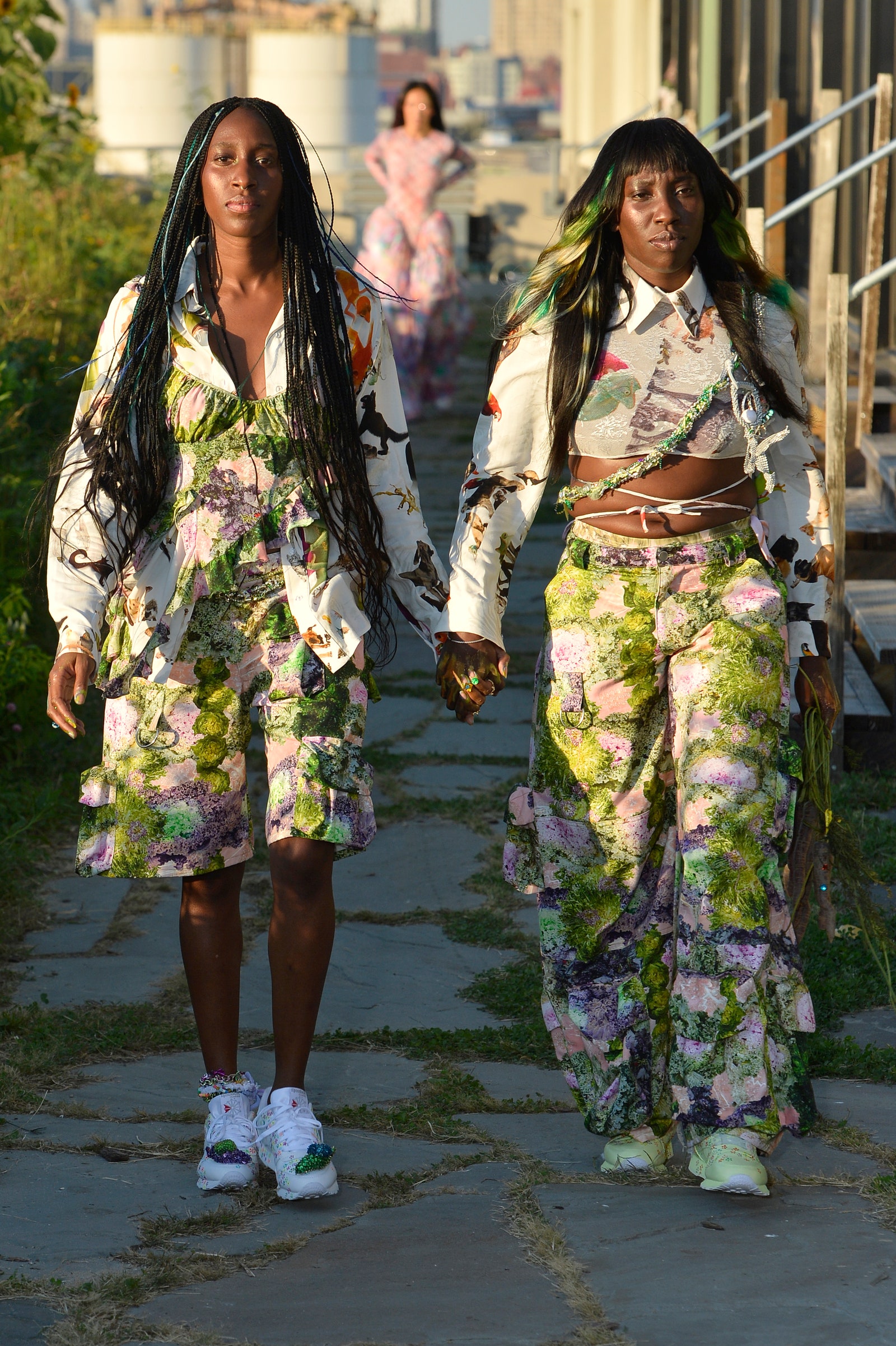Fashion week is back, baby, though it seems, like everything else that’s back, baby, many people’s private feelings are at odds with the propagandic positivity being peddled by industry elders. “If
it were up to me,” one fellow fashion journalist texted me this past weekend, “I’d rather be in my room watching Law and Order with a chamber pot.”
NYFW, September 2021: Dun-dun!
But by Tuesday afternoon, when I was attending my first in-person fashion show since I was in Paris for the men’s shows in January of 2020, I was smiling, thinking, “I’m just so happy to be sitting in a jungle-themed nightclub in Midtown on this mushroom-shaped stool, next to this animatronic elephant, watching this person in an ostrich feather thong carry a tiny dog down an astroturf runway.”
The designer of this barely-there canine-friendly frock was Sintra Martins, a Parsons graduate (and former Thom Browne intern) who launched her label Saint Sintra last year. To a soundtrack of psycho-pop Blondie covers and millennial girl group B-sides, she showed clothes in conversation with the exhilaratingly irrational styles of the early-to-mid-2000s MTV Video Music Awards: crystals draped into a shape suggesting a mini bubble dress, court shoes and ruffles on Little Lord Fauntleroy-types, and Ibiza-ish rope skirts with mesh tops and dresses. Martins is a purveyor of what I’d call Depop Couture, a mixture of Club Kid kitchen-sink-and-thrift-shop DIY with the playful “adulting” attitude of Clueless plus an exuberance and occasional political incorrectness indebted to Galliano-era Dior. Actually, all the models were in some degree of undress—thongs and nipples were almost always visible. Which is either a sign of liberation or an emperor’s new clothes situation, depending on your level of cynicism.
Pairs of models at the Collina Strada show.
Fernanda CalfatWhat makes this new strain of fashion interesting is the way the runway seems to reflect the audience, creating a loop of inspiration and representation. Fashion week has always attracted peacocks, and began drawing a new breed when the industry started opening its doors over a decade ago to bloggers whose fanaticism for fashion violated the pristine terms establishment editors followed for modest fashion show dressing. But in the chaos of the past 18 months, a number of young people began seeing themselves as their own greatest visual creation and designers and PRs have responded in kind. That means that these in-person shows are primed to be a locus of industry shock, perhaps an upending of the old order. The fringe characters who once preened before photographers are now perhaps the dominant strain: outside the show, people were smoking cigarettes in polyester nightgowns, in lucite platform heels and a Statue of Liberty robe, in a Prada sleeveless neoprene dress affixed with red satin puff sleeves. I chatted with Gutes Guterman, the co-editor of the Drunken Canal, which is releasing a fashion issue this week that lovingly parodies the cover of Vogue’s September issue, and sponsored a party with Saint Sintra—which should tell you something about the new order, that the indie media darling of the week is a freewheeling zine-ish art project launched in summer 2020. Guterman’s friend, a model, chatted with us while changing from a denim miniskirt and tank top to a more masc pair of black trousers and a T-shirt for a Prabal Gurung casting, revealing the waistband of their briefs to me and the rest of 57th Street.
Something strange was happening: in my vintage Atelier Versace shirt and Casey Casey pants, I felt underdressed. It seemed that the attitude and characters of URL had taken over IRL. I pointed this out to a friend, a streetstyle photographer who’s been on the scene for ages. “Well,” he said, “that’s because there are no editors.” I looked around, and indeed, though we were at a small show, a buzzy young designer’s first, there were indeed no other magazine types, no one dressed briskly, for business, during fashion week. In fact, everyone was either dressed like Evan Mock—cool T-shirts and subtly funky pants with sports drink-colored hair—or Carrie Bradshaw: in little pencil skirts and modest, expensive heels, in which the cute show of mid-century domesticity is violated by a revealing crop top.

